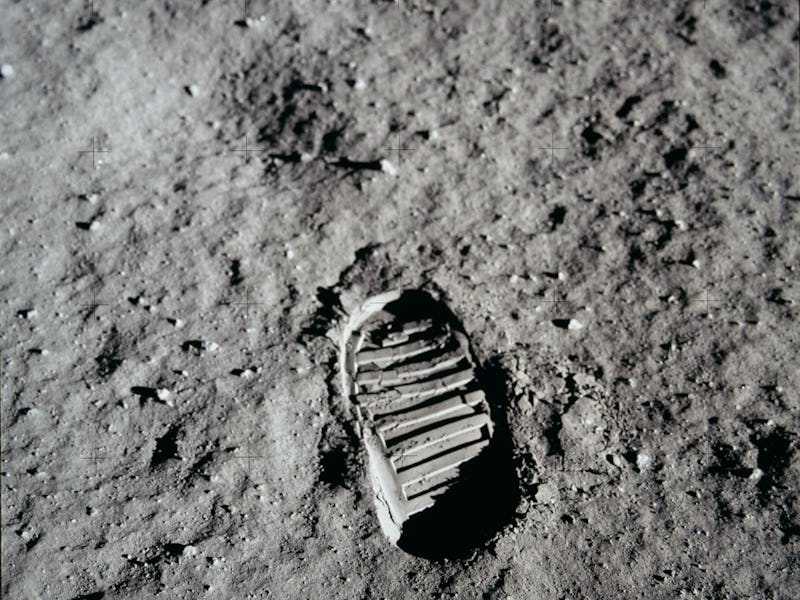NASA is trying to deal with its most annoying problem on the Moon
The lunar surface can get a little dusty.

As the Apollo astronauts landed on the Moon, it was one small step for man and a whole lot of dust for man to deal with.
Dust from the Moon’s surface got into camera lenses, caused radiators to overheat, and even damaged the astronauts’ spacesuits.
As NASA plans a human return to the Moon through the Artemis mission, the space agency is developing ways to mitigate the lunar dust so that it doesn’t interfere with equipment and ensure a more sustainable stay on the Moon.
NASA didn’t even realize they had a dust problem until they landed the first man on the Moon.
Erica Montbach, project manager of the lunar dust mitigation project at NASA’s Glenn Research Center in Cleveland, says that images from the Apollo mission revealed the damage caused by the dust.
“There was some of the equipment that overheated because the lunar dust prevented the heat from radiating away as it was supposed to and mechanical clogging of equipment,” Montbach tells Inverse. “Things started to not work.”
The dust also got into the cabin screen of the spacecraft, and the astronauts’ spacesuits had significant tears from the dust. Aside from that, the astronauts potentially breathing in the dust could pose a health risk.
The problem comes not just from the amount of dust, but from its very structure.
Unlike dust on Earth, lunar dust is particularly pesky to deal with as it can stick to surfaces like static and is easily kicked up by any activity.
Moon dust— On Earth, dust particles are smoothed out through the process of erosion, whether it be running water from rivers or winds that round out dust’s rough edges.
But on the Moon, this process doesn’t take place, which makes lunar dust sharp and angular.
“The lunar dust comes from the lunar regolith, which are the rocks and minerals that are on the Moon, and they tend to have more jagged edges on the fine particulate,” Montbach says.
Lunar dust also behaves differently. The dust on the Sun-facing side of the Moon is affected by solar radiation which gives it a positive electrical charge. As a result, the dust on the Moon would cling to everything sort of like static.
“There's that static factor that makes the lunar dust so difficult to prevent from damaging the equipment and the materials that go to the Moon,” Montbach says.
On the Moon, any activity on the surface would also cause large amounts of dust to kick up.
How do you deal with dust on the Moon?
In 2019, NASA created the Lunar Surface Innovation Initiative (LSII) to come up with new technologies needed for future exploration of the Moon, with dust mitigation being one of the main priorities.
The initiative came up with active and passive mitigation technologies for different kinds of equipment like rovers, power systems, spacesuits, and other types of hardware that NASA would send to the Moon.
Sharon Miller, the dust shedding material program’s principal investigator at NASA Glenn, says the combination of the passive and active techniques will allow the dust to be removed from the surface area while reducing the amount of power needed to remove it.
“The equipment that we're using is a variety of things from the different NASA centers,” Miller tells Inverse.
You don’t want to breathe this stuff, truly.
Some of the ideas that are currently being developed include ion-beamed deposited coating or laser patterned surfaces.
The team has started developing these materials and testing them in the lab, experimenting with different textures and combinations. NASA is then planning on testing these experimental solutions on the surface of the Moon starting in 2023.
“The solutions that we're working on are ‘leave no damage behind’ type of solutions,” Montbach says. “These are things that will only affect the equipment and prevent the equipment from being damaged by the dust, but will not do anything specifically to change what is on the Moon.”
The solutions are not only for missions like Apollo, but are designed for a longer, more sustainable stay on the Moon as NASA plans on building a lunar base on the Moon.
“A lot of what has begun this interest in this need is to try and find solutions not only for shorter missions but potentially that would work for longer missions as well,” Montbach says.